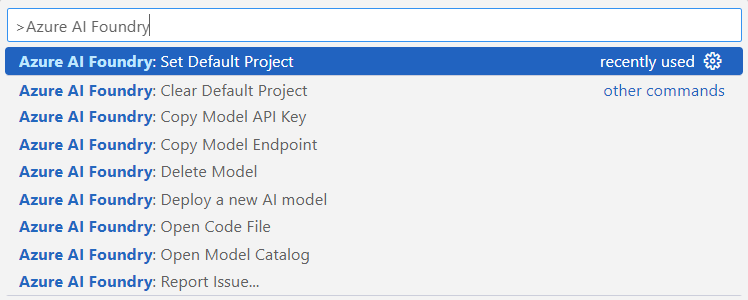Azure AI Foundry vs Azure AI Services vs Azure Machine Learning
 Daniel McLoughlin
Daniel McLoughlin
Introduction
I've seen a lot of confusion recently about Azure AI Foundry and its role in the Azure AI ecosystem. Specifically, people are assuming Foundry is a full machine learning platform where you can train and run ML workloads. To make matters worse, a recent change in the Azure portal has renamed "Azure AI Services" to "AI Foundry," adding even more fuel to the fire.
Let's clear this up.
Azure AI Foundry: What It Actually Is

Azure AI Foundry is Microsoft's GenAI orchestration platform. It helps you build generative AI applications by bringing together:
Model catalogues (Azure OpenAI, OSS models, 3rd party models)
Prompt Flow integration
Fine-tuning for foundation models
Evaluation tooling
Responsible AI guardrails
Deployment endpoints
Agent and application templates
It's designed for building GenAI apps - not for classical machine learning.
You deploy Azure AI Foundry as an Azure resource, and access it via its own portal.

I go into much more detail on what Foundry is (and isn't) in my earlier post: "Azure AI Foundry: What It Is & What It Isn't".
What Foundry Is Not
Azure AI Foundry is not:
A platform for training ML models from your own data
A replacement for Azure Machine Learning
A full MLOps pipeline
Azure Machine Learning: Where ML Lives

If you're doing traditional ML - training models, running experiments, managing pipelines - you still use Azure Machine Learning. That's where the full ML workflow lives, including hyperparameter tuning, feature stores, custom models, and deployment.
Much like Azure AI Foundry, you deploy Azure Machine Learning as an Azure resource, and access it via its own portal, called Azure Machine Learning Studio.

The Portal Rename: The Root of the Confusion

The Azure portal renamed the "AI Services" blade to "AI Foundry". This blade now includes:
The Foundry platform itself
Azure OpenAI, AI Foundry (projects), AI Hubs (parents of the projects), AI Search
All the classic Cognitive Services (Vision, Speech, Language, Document Intelligence, etc.)
Azure Machine Learning (still listed as a separate resource)
Seeing all these services under the "AI Foundry" banner is leading people to assume Foundry now includes ML capabilities. It doesn't.
Azure Databricks is not included in any of this.
A Quick Word on Using Code
Regardless of whether you're using Azure AI Foundry or Azure Machine Learning, both platforms can be accessed programmatically using languages like Python. For Foundry, this typically involves working with the Azure SDKs, REST APIs, or integrating with tools like Prompt Flow in code. For Azure Machine Learning, Python is often the primary interface - from data preparation and training to deployment and monitoring, with full SDK support for end-to-end ML workflows.
You can also work with both platforms directly from Visual Studio Code. With or without extensions, VS Code gives you flexibility to write and manage code, interact with Azure resources, and integrate with version control. Microsoft offers specific extensions for Azure Machine Learning and Azure AI Foundry (in preview) that simplify code level integration with the deployed platform in Azure.
When it comes to endpoints, both Foundry and Azure ML allow you to manage deployment endpoints directly in the Azure portal. In Foundry, once you've selected and deployed a model from the model catalogue, an endpoint is automatically provisioned for you. You can then retrieve the endpoint URL and keys directly from the portal for use in your applications. Azure ML offers similar functionality for deploying custom models, exposing them as managed web services that can be consumed via REST APIs or integrated into larger applications.
Quick Rule of Thumb
Building GenAI apps? Use Azure AI Foundry.
Running ML workloads? Use Azure Machine Learning or Azure Databricks.
Using pre-trained APIs? Use the services within the AI Foundry portal blade (formerly Cognitive Services and AI Services).
Hopefully this helps cut through the noise. The Azure AI landscape is evolving fast, and it's easy to get tripped up - I'm learning it in public so you don't have to.
Further Reading
If you're interested in more context on Foundry, check out my earlier posts:
Subscribe to my newsletter
Read articles from Daniel McLoughlin directly inside your inbox. Subscribe to the newsletter, and don't miss out.
Written by

Daniel McLoughlin
Daniel McLoughlin
As a Technology Strategist, I help organisations bring clarity to complexity - connecting technology, business strategy and practical delivery. I currently work for Version 1, where I advise on how emerging technologies can be applied to create real business value - enabling organisations to adapt, innovate and scale with confidence. My background allows me to navigate both the strategic 'what' and 'why', while drawing on years of technical experience to understand enough of the 'how' to ensure strategies are grounded, practical and sustainable. In a rapidly evolving technology landscape, I focus on solving ambiguity - helping organisations make sense of emerging trends, partner ecosystems and shifting capabilities, while identifying opportunities that align with long-term business objectives. My approach is to bridge the gap between vision and execution, providing clear thinking in the midst of change and complexity.
